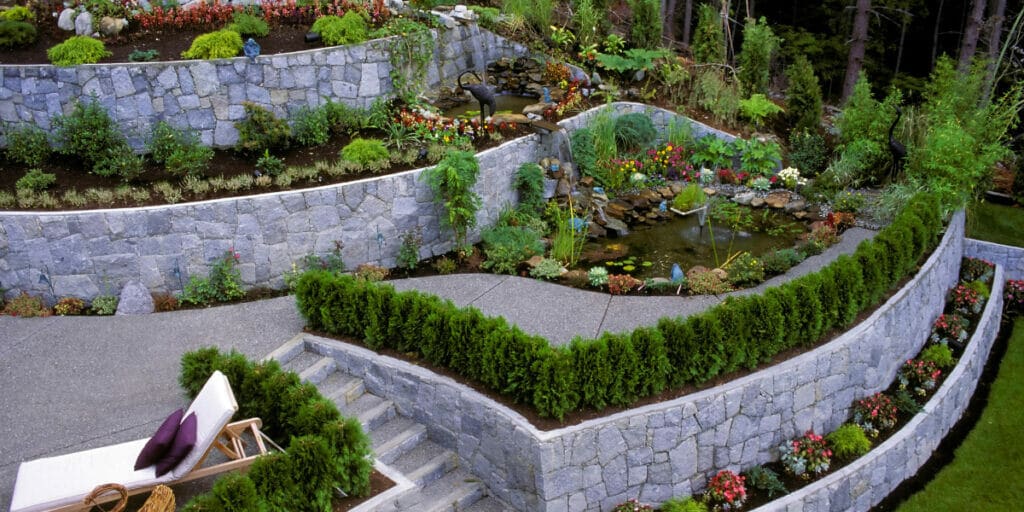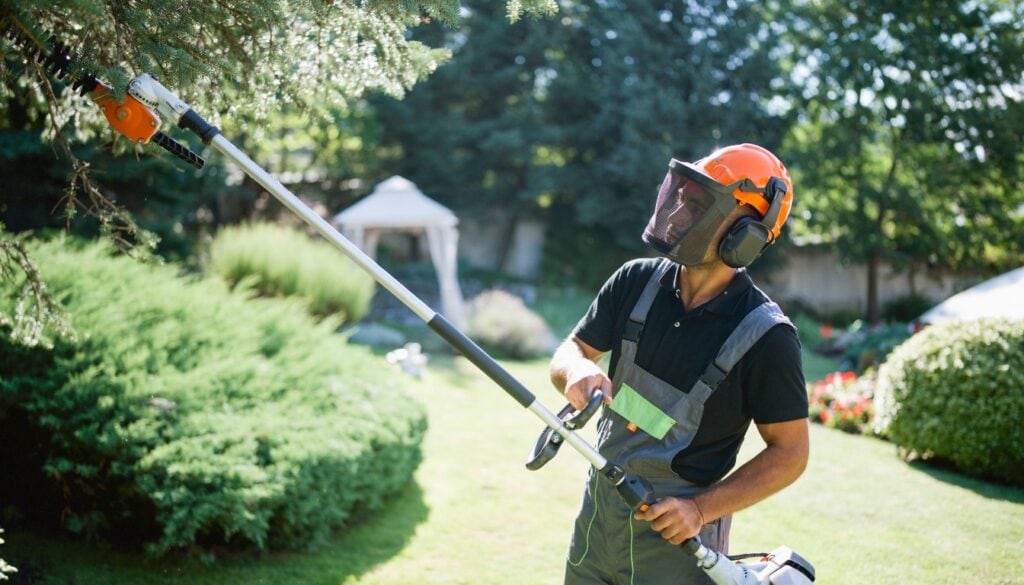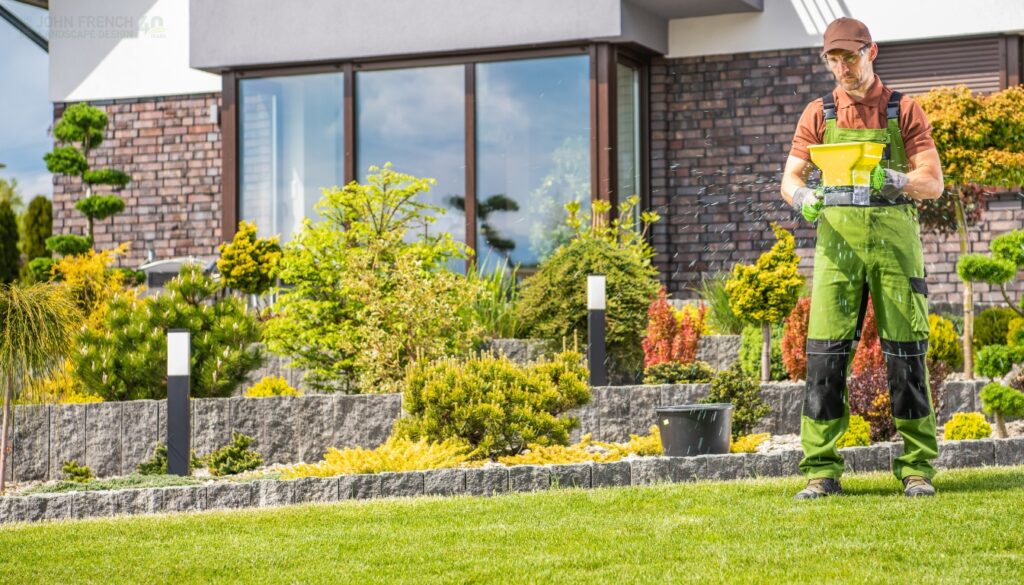Elevate and Contain: Incorporating Retaining Walls into Your Landscape Design
Are you tired of watching your landscape erode away? Well, fret no more! Retaining walls are here to save the day. These sturdy structures, like a fortress standing against the forces of nature, hold back soil and prevent erosion. They provide stability and create usable spaces in your yard that were once deemed impossible.
With various types, construction methods, and design options available, there is a retaining wall solution for every need and aesthetic preference. Whether you’re looking to add a touch of elegance to your garden or create a functional terrace on a sloping property, retaining walls are the answer.
But it doesn’t end there. In this article, we’ll also cover important considerations, maintenance tips, and repair strategies to ensure your retaining wall stands the test of time.
So, buckle up and get ready to transform your landscape with the power of retaining walls!
Key Takeaways
– Materials for retaining walls: concrete and stone
– Landscaping and greenery enhance aesthetic appeal and offer environmental benefits
– Lighting installation enhances ambiance and makes retaining walls stand out
– Regular inspection and maintenance are essential for the longevity and functionality of retaining walls.
Types of Retaining Walls
There’s a wide variety of retaining walls to choose from, each offering unique benefits and aesthetics to suit any landscaping project. When it comes to soil stability and erosion control, retaining walls play a crucial role.
One popular type is the gravity retaining wall, which relies on its own weight to hold the soil in place. It is a cost-effective option and can be constructed using various materials such as concrete, stone, or timber.
Another option is the cantilever retaining wall, which uses a reinforced concrete slab to support the soil. It provides excellent stability and is often used for taller walls.
Additionally, there are also anchored retaining walls that use cables or rods for added support. These walls are ideal for areas with loose or sandy soil.
With such a wide range of options, you can easily find a retaining wall that meets your specific needs for both soil stability and erosion control.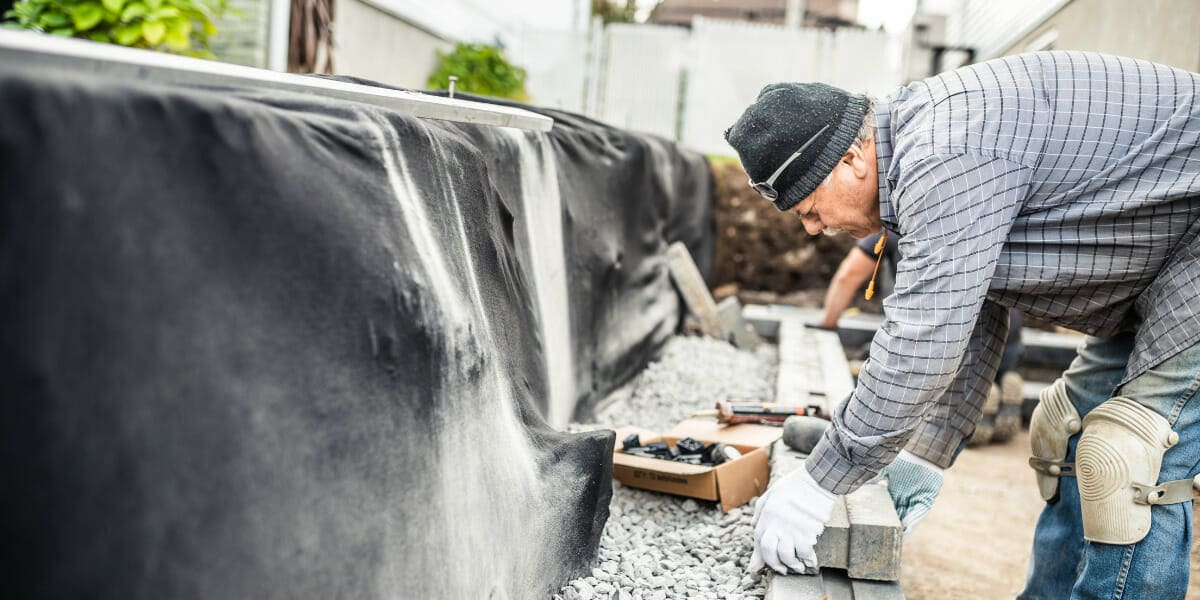
Construction Methods
When constructing a retaining wall, there are three key points to consider: excavation and foundation preparation, wall building techniques, and drainage systems.
Excavation and foundation preparation involves digging a trench and ensuring a solid base for the wall to be built upon. This step is crucial for the stability and longevity of the retaining wall.
Wall building techniques vary depending on the mater ials used. For example, if concrete blocks are being used, they can be stacked and secured with mortar. On the other hand, if stone is being used, a dry stone technique may be employed, where stones are stacked without mortar.
Lastly, drainage systems are essential for preventing water buildup behind the wall. Without proper drainage, water can accumulate and exert pressure on the wall, leading to potential damage over time.
By considering these three points and implementing appropriate construction methods, you can ensure the durability and effectiveness of your retaining wall.
Excavation and Foundation Preparation
To properly prepare the foundation for your retaining wall, you’ll need to dig a trench to the appropriate depth and width. This is a crucial step in ensuring the stability and longevity of your wall. Here are some excavation techniques and soil stabilization methods that you can employ:
– Excavation Techniques:
– Traditional Excavation: This involves using heavy machinery like excavators and backhoes to remove soil and create the trench.
– Hand Excavation: For smaller projects or areas with limited access, manual digging with shovels and picks can be done.
– Soil Stabilization Methods:
– Compaction: After excavation, the soil should be compacted using a compactor or vibrating plate to increase its density and strength.
– Geogrid Installation: This involves placing geogrids within the soil layers to provide additional reinforcement and prevent lateral movement.
– Gravel Backfill: Backfilling the trench with gravel helps with drainage and adds stability to the foundation.
By employing these techniques and methods, you can ensure a solid foundation for your retaining wall that will withstand the test of time.
Wall Building Techniques
Using proper building techniques is essential for creating a strong and durable structure that will stand the test of time. When it comes to building retaining walls, two important aspects to consider are wall reinforcement and soil erosion.
Wall reinforcement involves adding materials such as steel bars or mesh to strengthen the wall and prevent it from collapsing under pressure. This is especially important for walls that are built to hold back large amounts of soil or water.
Proper techniques for addressing soil erosion can help maintain the stability of the wall. This can include incorporating drainage systems to redirect water away from the wall, as well as using erosion control measures such as geotextiles or retaining wall blocks to prevent the soil from eroding and undermining the structure.
By implementing these techniques, you can ensure that your retaining wall remains strong and resilient for years to come.
Drainage Systems
Imagine your structure as a fortress, fortified with a network of drainage systems to channel water away, ensuring its strength and longevity. To protect your retaining wall from water damage, it is essential to incorporate waterproofing systems and erosion control techniques. Waterproofing systems, such as membranes or coatings, create a barrier that prevents water from seeping into the wall and causing damage. Additionally, implementing erosion control measures, such as gravel-filled trenches or French drains, helps redirect water and prevent soil erosion around the wall. These drainage systems work together to alleviate hydrostatic pressure and protect your retaining wall from potential failure. By investing in proper drainage, you can enhance the durability and lifespan of your structure, ensuring its stability for years to come.
| Waterproofing Systems | Erosion Control | Drainage Systems |
| ——————– | ————– | —————- |
| Membranes | Gravel-filled trenches | French drains |
| Coatings | Soil erosion prevention | Downspout extensions |
| | Vegetation control | |
Important Considerations
One crucial factor to consider when designing and constructing retaining walls is the type of soil in the area. The type of soil can affect the stability and longevity of the retaining wall, so it is important to assess the soil conditions before starting the project.
Here are some important considerations regarding retaining walls:
– Retaining Wall Costs: The cost of building a retaining wall can vary depending on factors such as the height, length, and materials used. It is important to consider your budget and choose materials that are cost-effective and durable.
– Retaining Wall Safety: Safety should always be a top priority when building retaining walls. It is important to ensure that the wall is structurally sound and can withstand the pressure exerted by the soil. Hiring a professional engineer or contractor can help ensure that the wall is built to code and meets safety standards.
– Drainage: Proper drainage is essential for the longevity of the retaining wall. Without adequate drainage, water can build up behind the wall, causing pressure and potential damage. Installing a drainage system, such as French drains or weep holes, can help prevent water buildup and protect the integrity of the wall.
– Maintenance: Retaining walls require regular maintenance to ensure their effectiveness and longevity. This can include inspecting for cracks or signs of damage, repairing any issues promptly, and keeping the area around the wall clear of debris.
– Aesthetics: While functionality is important, considering the aesthetic appeal of the retaining wall is also crucial. Choosing materials, colors, and designs that complement the surrounding landscape can enhance the overall appearance of the area.
In conclusion, when designing and constructing retaining walls, it is essential to consider factors such as soil type, costs, safety, drainage, maintenance, and aesthetics. Taking these factors into account will help ensure the durability, effectiveness, and overall success of the retaining wall project.
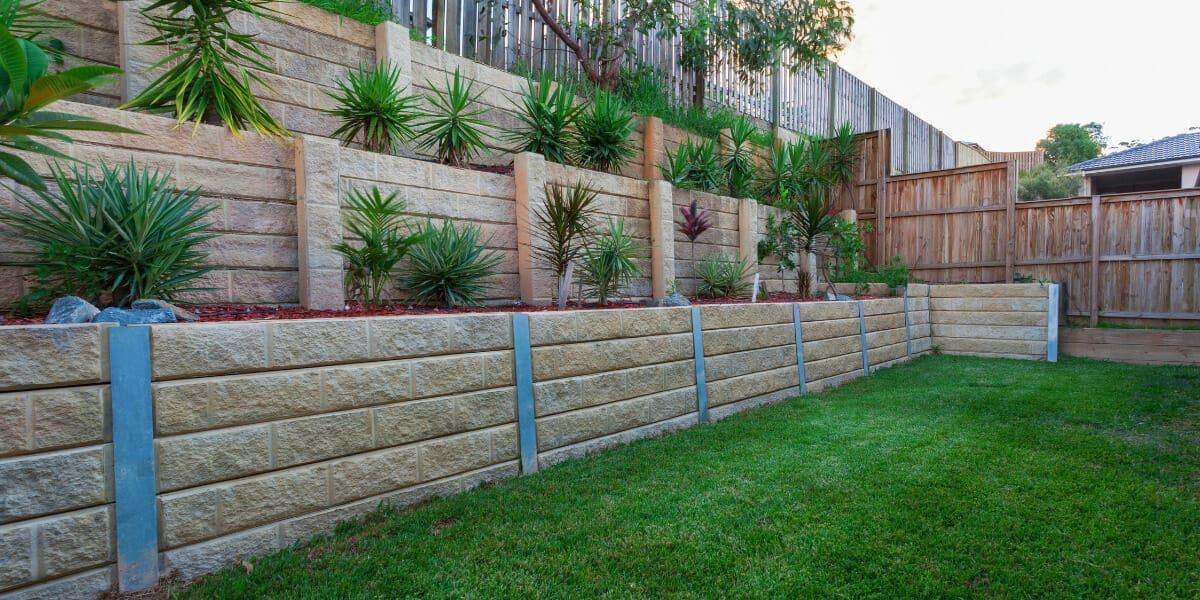
Design Options and Aesthetics
When designing a retaining wall, there are several key points to consider.
First, you need to think about the materials and finishes that will be used. This can greatly impact the aesthetic appeal of the wall.
Additionally, incorporating landscaping and greenery into the design can soften the look of the wall and make it blend in with the surrounding environment.
Lastly, adding lighting and decorative elements can enhance the overall appearance and functionality of the wall, making it a focal point in your outdoor space.
Materials and Finishes
To achieve a polished and durable look for your retaining wall, consider using materials such as concrete or stone with finishes like stucco or brick veneer. These materials offer a range of options for both aesthetic appeal and functionality. Concrete is a popular choice due to its strength and versatility. It can be molded into various shapes and sizes, allowing for customized designs. Stone, on the other hand, provides a natural and timeless look. It is available in different types, such as limestone or granite, each offering unique textures and colors. When selecting materials, it’s important to consider cost considerations. Concrete tends to be more affordable compared to stone, but both options can be cost-effective in the long run due to their durability and low maintenance requirements.
| Material | Aesthetic Appeal | Cost |
|————–|—————–|——|
| Concrete | Versatile | Low |
| Stone | Natural | High |
| Brick Veneer | Classic | Medium |
### Incorporating Landscaping and Greenery
Imagine how delightful it would be to surround your structure with lush greenery and vibrant landscaping, creating a captivating contrast to the cold, hard materials used in its construction. By incorporating landscaping design into your retaining walls, you not only enhance the aesthetic appeal but also reap numerous environmental benefits.
The strategic placement of plants, shrubs, and trees can soften the harsh lines of the walls and blend them seamlessly into the surrounding environment. With careful selection of native plants, you can create a sustainable ecosystem that attracts local wildlife and promotes biodiversity.
Moreover, the greenery acts as a natural filter, improving air quality by absorbing pollutants and reducing noise levels. The presence of landscaping can also help control soil erosion by holding the soil in place and preventing excessive water runoff.
So, not only do you get an eye-catching design, but you also contribute to a healthier and more sustainable environment.
Adding Lighting and Decorative Elements to Your Landscape
Now that you’ve learned about incorporating landscaping and greenery into your retaining walls, let’s take it a step further by adding lighting and decorative elements.
Lighting installation is a great way to enhance the ambiance of your outdoor space and make your retaining walls stand out even more. You can choose from a variety of options such as solar-powered lights or low-voltage LED lights, depending on your preference and budget. These lights can be strategically placed to highlight the architectural features of your retaining walls or to illuminate pathways and stairs for safety.
In addition to lighting, you can also consider adding ornamental features like sculptures, wall art, or decorative stones to further enhance the aesthetics of your retaining walls. These elements will not only add character but also make your outdoor space feel more inviting and visually appealing.
Maintenance and Repair
You can easily maintain and repair retaining walls to ensure their longevity and functionality. Here are some maintenance tips to keep in mind:
– Regularly inspect the retaining wall for any signs of damage such as cracks or bulging.
– Clean the wall regularly by removing any debris or vegetation that may have accumulated.
– Check the drainage system to ensure it is functioning properly and clear any blockages.
Common issues that may require repair include:
– Failing or damaged drainage system, which can lead to water accumulation and pressure on the wall.
– Cracked or shifted blocks, which can compromise the stability of the wall.
– Erosion or settlement of the soil behind the wall, which can cause the wall to lean or collapse.
By following these maintenance tips and promptly addressing any issues, you can ensure that your retaining wall remains strong and functional for years to come.
Frequently Asked Questions
How long do retaining walls typically last?
Retaining walls, like sturdy foundations, can stand the test of time. With proper maintenance, they can last for decades, providing long-term durability. Regular upkeep is essential to ensure their structural integrity and prevent potential issues.
Can retaining walls be built on sloped terrain?
Yes, retaining walls can be built on sloped terrain. Retaining wall design allows for the creation of level surfaces and prevents soil erosion. The benefits of using retaining walls include added stability and enhanced landscaping opportunities.
Are there any restrictions or permits required for building a retaining wall?
Building a retaining wall? Well, brace yourself for a bureaucratic adventure! Before you start, make sure you comply with all those thrilling permit requirements and construction regulations. Fun times ahead!
What are the common signs of damage or failure in a retaining wall?
Common signs of damage or failure in retaining walls include leaning or tilting, cracks or bulges, water accumulation, and soil erosion. These issues can occur over time, shortening the retaining wall’s lifespan.
Are there any environmentally-friendly options for constructing retaining walls?
Yes, there are environmentally-friendly options for constructing walls. You can use eco-friendly materials like recycled concrete or natural stone, and employ construction techniques that minimize disruption to the environment.
Conclusion
In conclusion, retaining walls are essential structures that provide support and prevent soil erosion. By understanding the different types of retaining walls, construction methods, and important considerations, you can ensure the longevity and functionality of your retaining wall.
Design options for retaining walls should also be carefully considered. Factors such as the height of the wall, type of soil, and desired aesthetic should all be taken into account. This will help you choose the best design that meets your specific needs.
Maintenance and repair are also important aspects to consider. Regular inspections should be conducted to check for any signs of damage or instability. If any issues are found, prompt repairs should be made to prevent further damage.
A case study of a homeowner with a sloped backyard provides a practical example of the benefits of a properly constructed retaining wall. In this case, the retaining wall not only enhanced the aesthetics of their outdoor space but also prevented soil erosion. This created a safer and more usable area for their family to enjoy.
In summary, retaining walls play a crucial role in providing support and preventing soil erosion. By understanding the different types, construction methods, and important considerations, as well as properly maintaining and repairing them, you can ensure the longevity and functionality of your retaining wall.

